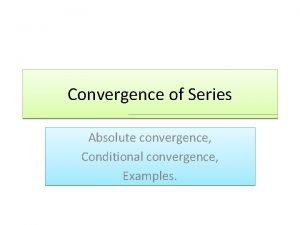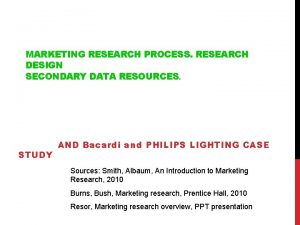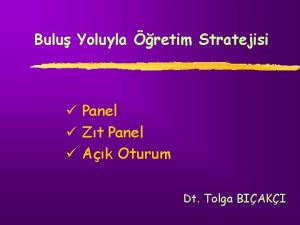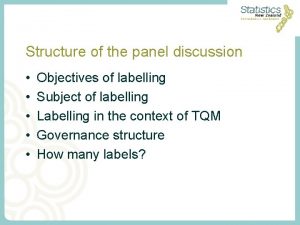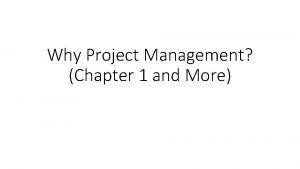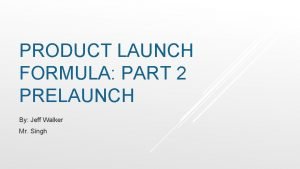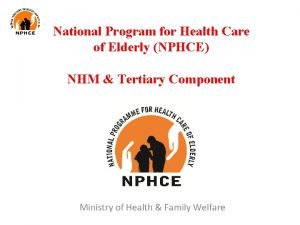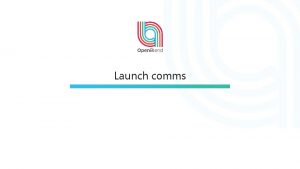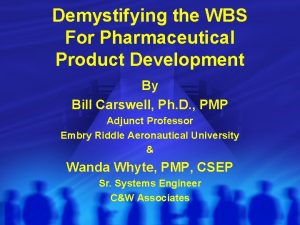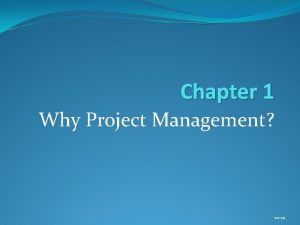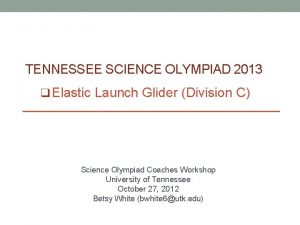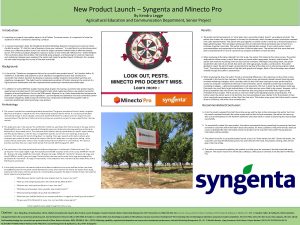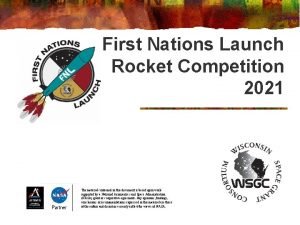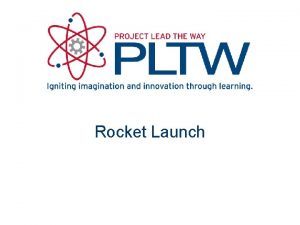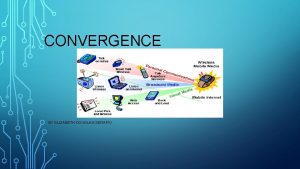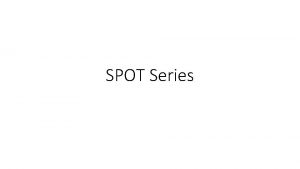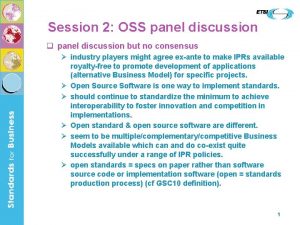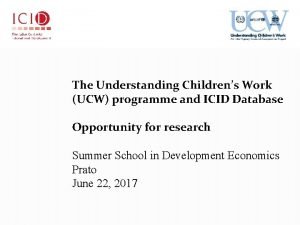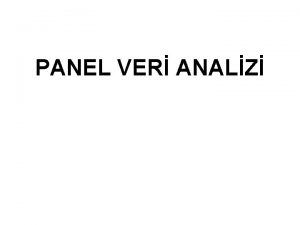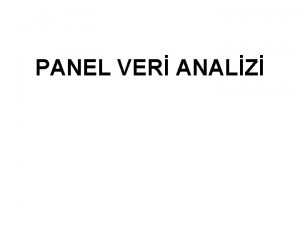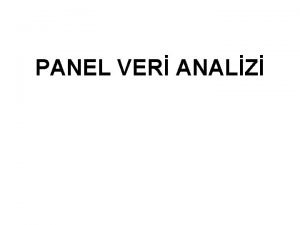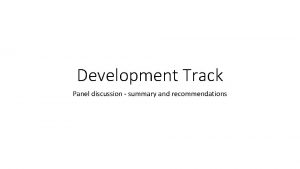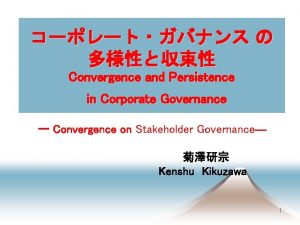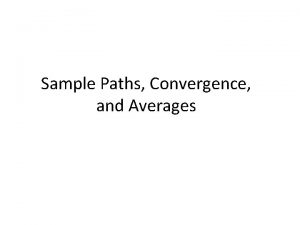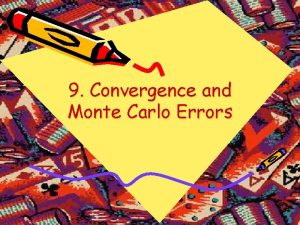PLOS Convergence Collection Launch and Panel Discussion ICID





























- Slides: 29

PLOS Convergence Collection Launch and Panel Discussion ICID Hyderabad, India 3 March 2016 Larry Peiperl MD Chief Editor, PLOS Medicine

Publishing Today in Open Access http: //collections. plos. org/grand-convergence

Fig 1. Impact of enhanced health investments on under-five mortality rate in low- and lowermiddle-income countries. Kruk ME, Yamey G, Angell SY, Beith A, Cotlear D, et al. (2016) Transforming Global Health by Improving the Science of Scale-Up. PLo. S Biol 14(3): e 1002360. doi: 10. 1371/journal. pbio. 1002360 http: //journals. plos. org/plosbiology/article? id=info: doi/10. 1371/journal. pbio. 1002360

The Lancet Commission on Investing in Health Jamison DT et al. Lancet 2013; 382: 1898– 955 • Re-examines the case for investing in health • Proposes a health investment framework for low- and middleincome countries • Provides a roadmap to achieving gains in global health through a ‘grand convergence’

Steps to Achieve Convergence Rapid scale-up of life-saving interventions Build strong health delivery systems Convergence interventions: • Reproductive maternal, newborn, and child health • HIV • Malaria • Tuberculosis • Neglected tropical diseases Discover and develop new tools

Impact and Cost of Convergence Low-income countries Lower middle-income countries Annual deaths averted from 2035 onwards 4. 5 million 5. 8 million Approximate incremental cost per year, 2016 -2035 $25 billion $45 billion Proportion of costs devoted to structural investments in health system 60 -70% 30 -40% Proportion of health gap closed by existing tools (rest closed by R&D) 2/3 4/5



Convergence requires new technologies AND People must benefit from them • Secure funding for R&D • Overcome “market failure” – profit motive not aligned with health need • Strengthen delivery systems • Address “demand side” barriers to uptake • Allocate resources optimally between existing and new technologies

Thank You! Editorial and Publications Staff of PLOS Biology, PLOS Medicine, PLOS NTDs PLOS Collections and Marketing teams Sara Fewer, UCSF Global Health Group, Evidence to Policy Initiative Guest Editors Gavin Yamey, Duke Global Health Institute, USA, and Carlos Morel, Center for Technological Development in Health Oswaldo Cruz Foundation (Fiocruz) Brazil Bill and Melinda Gates Foundation

Distinguished Panel • Soumya Swaminathan Secretary, Department of Health Research, Ministry of Health and Family Welfare, Government of India, and Director General of Indian Council of Medical Research • Stephan Duparc Chief Medical Officer, Medicines for Malaria Venture • Cyril Engmann Program Leader, Maternal, Newborn, and Child Health and Nutrition, PATH • Harish Iyer Senior Scientific Advisor, Scientific Programs, India Country Office, Bill and Melinda Gates Foundation

Soumya Swaminathan Secretary, Department of Health Research, Ministry of Health and Family Welfare, Government of India, and Director General of Indian Council of Medical Research

Stephan Duparc Chief Medical Officer, Medicines for Malaria Venture

MMV’s Supported Projects Research Lead generation Miniportfolio Novartis Lead optimization 1 project Novartis Translational Preclinical P 218 (Biotec) Human volunteers MMV 048 UCT/TIA Product development Patient exploratory OZ 439/PQP Sanofi Patient confirmatory Tafenoquine GSK Access Regulatory review Post approval Artemetherlumefantrine Dispersible Rectal Artesunate * Cipla/Strides/WHO-TDR Novartis Miniportfolio GSK Miniportfolio 2 projects GSK Orthologue Leads SJ 733 St Jude/Eisai DDD 498 Sanofi Merck Serono (Univ. Dundee) Heterocycles Tetraoxanes PA 92 Univ. Campinas LSTM/Univ. Liverpool (Drexel/UW/GNF) OZ 439/FQ Sanofi Dihydroartemisinin piperaquine Artesunate for injection Paediatric Sigma-Tau Guilin Heterocycles Daiichi-Sankyo UTSW/UW/Monash MMV 253 (Astra. Zeneca) Dihydro-artemisinin - piperaquine Sigma-Tau 3 KAF 156 Pyronaridineartesunate Novartis DSM 265 Artesunateamodiaquine * Takeda Sanofi/ DNDi Heterocycles Takeda Heterocycles Eisai Heterocycles UCT Open Source Drug Discovery Univ. Sydney Screening Merck Serono Pathogen Box MMV Other projects 24 projects 31 December 2015 Heterocycles Celgene GSK 030 (UTSW/UW/ Monash) GSK 692 Whole cell St Jude/Rutgers/USF Diversity oriented Synthesis Broad/Eisai Anacor 5 Cipla/DNDi To develop the individual compounds for combination into the TPPs, MMV has defined five Target Candidate Profiles (TCPs): Asexual blood stage activity (TCP 1, 2) Relapse prevention (TCP 3 a) Transmission reduction (TCP 3 b) Chemoprevention (TCP 4) GSK AN 13762 4 Artesunate. Mefloquine * GSK DSM 421 2 KAE 609 Shin Poong DHODH 1 SPAQ * Guilin 6 Pyronaridine. Artesunate Paediatric Shin Poong Brought into portfolio after approval. Collaboration with DNDi Footnotes: Brand names 1: Coartem® Dispersible; 2: Artesun®; 3: Eurartesim®; 4: Pyramax®; 5: Coarsucam. TM ASAQ/Winthrop®; 6: SPAQ-COTM

Transformative Innovations in Maternal, Newborn, and Child Health Over the Next 20 Years

PLOS Authors Cyril M. Engmann, MD, FAAP: Maternal, Newborn, Child Health and Nutrition, PATH & Department of Pediatrics, Neonatology, University of Washington, Seattle, Washington, United States Sadaf A. Khan, MD, Dr. PH: Maternal, Newborn, Child Health and Nutrition, PATH, Seattle, Washington, United States Cheryl A. Moyer, MPH, Ph. D: Departments of Learning Health Sciences and Obstetrics & Gynecology, University of Michigan Medical School, Ann Arbor, Michigan, United States Patricia S. Coffey, Ph. D: Technical Solutions, PATH, Seattle, Washington, United States Zulfiqar A. Bhutta, MD, Ph. D: Center for Global Child Health, Sick Kids, Toronto, Ontario, Canada. Center of Excellence in Women and Child Health, Aga Khan University, Karachi, Pakistan 3/2/2021 1: 01 PM


Essential areas of innovation for improving RMNCAH Commodities and Supply Chain Improvements New Methods of Financing New Technologies Healthcare System Addressing Supply. Side Barriers to Increase Access Addressing Demand-Side Barriers to Increase Access Improvements in Monitoring, Measurement, and Feedback

Challenges To Maximum Uptake/ Effectiveness of MNCH Innovations • Development of Innovation: Lack of user-centric focus to understand care-seeking behaviors and social/cultural preferences of women and communities, capabilities and resources of HCP, national and local policies, and local contexts in which it will be implemented. • Integration of Innovation – into existing programs, local contexts and the continuum of care, across different platforms and beyond. e. g. reinforcing consistent messaging across schools, churches, community & health centers • Enabling and Supportive Environments/Settings – to address the current social, medical, and logistic contexts and needs. 3/2/2021 1: 01 PM

Bringing US Congressional attention to progress still needed to improve RMNCAH&N globally • Complete unfinished MDG agenda • Survive & thrive • Bridge “know-do” gap, utilize implementation science to implement effectively at scale, • Improve quality of care at birth • Promote multi-sectoral, integrated RMNCAHN+ approach • Address displaced & urban poor • Strengthen life-cycle approaches especially preconception, stillbirth, adolescent health • Mental health

“Innovations matter. Innovations have powerful potential to result in transformative change when technologies are coupled with system-level, condition-sensitive, enabling environment's that support advocacy and political will, sufficient investment, large and well trained workforce, opportunities for real-time feedback and quality improvement”. PLOS Medicine, March 2016

“It always seems impossible until it is done” Nelson Mandela

ICID, 2016 Grand Convergence Innovation in Global Health March 2016 Harish Iyer

Adopted by the UN General Assembly in 2015 as goals for the next 15 YEARS © Bill & Melinda Gates Foundation | 24

WHAT WE FOCUS ON What are the areas of greatest need? Where can we have the greatest impact? © Bill & Melinda Gates Foundation | 25

HOW DO WE CHOOSE PROBLEMS? What are the areas of greatest need? Mundel (2016), PLo. S Biol. 14(3): e 1002376 Where can we have the greatest impact? © Bill & Melinda Gates Foundation | 26

OUR WORK IN INDIA Under-five mortality, India, 2012 Share by cause, percent INNOVATION IN DELIVERY AND R&D Innovation in Delivery a. Piloting programs in areas such as MNCH b. Supporting vaccine delivery and scale-up using technical units c. New ways of delivery to improve compliance Others 19% Malaria 1% Pneumonia 21% Innovation in R&D a. Data generation to understand where are b. New vaccines (Men. Afrivac, rotavirus, pneumo, cholera) c. Potential new therapies – HIV, TB d. Sanitation – re-inventing the toilet Use feedback and data to correct strategies Learn from mistakes & adapt in a complex environment Diarrhea 10% Measles 3% Neo Natal 42% Injury 4% Source: UNICEF Progress Report 2013; World Bank U 5 MR and BR data © Bill & Melinda Gates Foundation | 27

THE WORK IS COMPLICATED. WHY WE DO IT IS NOT.

Q&A
 Absolutely convergent
Absolutely convergent Continuous panel vs discontinuous panel
Continuous panel vs discontinuous panel Zıt panel tekniği
Zıt panel tekniği Objectives of panel discussion
Objectives of panel discussion Conclusion of panel discussion
Conclusion of panel discussion Sharon soper
Sharon soper Group discussion in tamil
Group discussion in tamil Simple distillation discussion
Simple distillation discussion Landsat collection 1 vs collection 2
Landsat collection 1 vs collection 2 Documentary collection
Documentary collection Optimal driver launch angle and spin rate chart
Optimal driver launch angle and spin rate chart Narrow product launch windows
Narrow product launch windows The product launch formula
The product launch formula Nphce launch date
Nphce launch date Let down in the deep
Let down in the deep Ideas for yammer posts
Ideas for yammer posts The openblend podcast
The openblend podcast Product development wbs
Product development wbs Narrow product launch windows
Narrow product launch windows Elastic launch glider
Elastic launch glider Launch housing frankston
Launch housing frankston Jwst launch
Jwst launch Launch simulink
Launch simulink James nasa says space launch its
James nasa says space launch its Fighter brand meaning
Fighter brand meaning Syngenta new product launch
Syngenta new product launch Narrow product launch windows
Narrow product launch windows That was due today
That was due today First nations launch
First nations launch Launch out into the deep
Launch out into the deep
